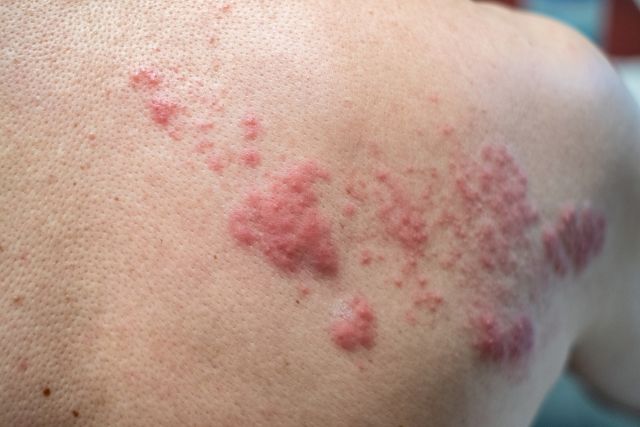Updated on April 30, 2025
One in three Americans will develop shingles during their lifetime, according to the Centers for Disease Control and Prevention (CDC). You can have shingles at any age, but the risk increases as you grow older; about half of all shingles cases happen among those age 60 and up. The shingles virus produces a painful rash that typically appears in a band on one side of your body, sometimes with a fever or headache.
“Shingles is caused by varicella zoster—the same virus that causes chickenpox,” says Wenny Jean, MD, a family medicine doctor in Dallas County, Iowa.
Anyone who’s had chickenpox can later develop shingles. That’s because the varicella zoster virus remains dormant, or inactive in your system, explains Dr. Jean. Later, the virus may reactivate as shingles if:
- Your immune system weakens from a serious medical condition, such as HIV or a cancer like leukemia or lymphoma
- You’re taking drugs, such as steroids, to suppress your immune system after an organ transplant
- You’re under a great deal of stress. Stress doesn’t directly cause shingles, but it can weaken your immune system, increasing your risk of an outbreak.
If you’ve never had chickenpox, you’re still at risk: If you come into contact with someone who has shingles while they’re contagious, you could develop chickenpox (which would then remain dormant in your system, potentially leading to a case of shingles later).
One important way to reduce your risk of getting varicella zoster is to get the shingles vaccine if you’re age 50 or older.
What are the symptoms of shingles?
The symptoms of shingles can include:
- Fevers
- Headaches, sensitivity to light
- Tiredness
- Chills
- Body aches
However, the most common symptoms are pain and a blistering rash. The shingles rash almost always appears on one side of your body in a “band” shape. You may feel itching, pain, or tingling in the area before the band appears. In rare cases, people with weak immune systems may have a rash that’s more widespread, crossing over onto both sides of their body.
The shingles rash includes blisters, which burst open and then crust over a period of about 7 to 10 days. The virus is contagious when your blisters are open, so it’s especially important to cover your rash during that time.
“Generally, we recommend for people who have shingles to quarantine, or isolate themselves when they’re contagious,” says Jean. “Don’t share close spaces with household members. Don't, of course, share clothing, bedding or things like that because you may shed the virus.”
How is shingles treated?
If you suspect that you have shingles, make an appointment with your healthcare provider (HCP) immediately. “Try to start treatment at least within 48 hours,” says Jean. “The first time you feel a tingle or see the first little bit of rash, get in to see your provider.”
Your HCP will prescribe anti-viral medications, drugs that fight the shingles virus to help your symptoms clear up as quickly as possible. Your HCP may also prescribe:
- Pain medications to make you more comfortable
- Creams, lotions, or medicated soaps to soothe and prevent infections in your open blisters
Taking the proper medications for shingles sooner, rather than later, can help you heal faster and prevent complications.
Complications of shingles
Some people with shingles may develop other conditions as a result of their infection. The most common complication of shingles is postherpetic neuralgia, or lingering nerve pain, which can last for years in certain cases. Other complications can include:
- Vision loss: This may occur in rare cases, usually when the rash appears on your face and involves one or both of your eyes.
- Neurological problems: Depending on where your rash is located, shingles could affect your nerves. In that case, the virus could interfere with your hearing, balance or other bodily functions.
- Infections in your open wounds: Keep other infections from setting in by following your HCP's instructions for wound care. Clean your blisters with warm water and any medicated soaps that your HCP prescribes, apply any prescription gels or creams, and cover the area with clean, non-stick gauze.
Because of these risks, it’s important to do everything you can to keep shingles from spreading if you develop it.
Don’t share the shingles virus
If you have shingles, keep it from spreading to others by:
- Touching your rash as little as possible and keeping it covered
- Washing your hands often, including every time you touch or clean your open wounds
- Avoiding public swimming pools, baths, or steam rooms until your rash has crusted over
- Staying away from people who are at high risk for developing severe chickenpox or shingles. That includes pregnant people who aren’t immune to chickenpox, preterm newborn babies, and people with weak immune systems, such as those who are undergoing cancer treatment or have HIV.
Even after you recover from shingles, it’s still possible to come down with it again. That’s why everyone age 50 and older should get vaccinated if their HCP recommends it, regardless of whether you’ve had the chickenpox or shingles in the past.
A new version of the vaccine was approved in 2017, and it is much more effective that the older version. The CDC recommends that you get it even if you already received the older shot.
If you qualify for the vaccine, ask your HCP about receiving it at your local pharmacy to keep yourself protected.






